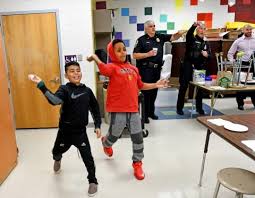Washington Post features Hutchison's Project Hope
The following is a reprint of a January 23, 2018 Washington Post article. Photos by Katherine Frey/The Washington Post.
Students hesitated when Renee Gorman shared the idea of inviting police officers to Hutchison Elementary School in Herndon, Va., for a new school club two years ago.
“They’re bad,” the kids said of police, Gorman recalled.
“They’re mean,” others would say.
The response, school officials said, reflected fears in the community around Hutchison, a school with newcomers from El Salvador and Honduras who arrive in Fairfax County seeking safety. About 70 percent of the school’s students are English learners.
Gorman, a school counselor, has worked with children whose parents were deported and who regard police warily. “It’s very hard to break down that vision that law enforcement didn’t cause this,” she said. “But we’ve been able to do that.”

The remedy, she said, has been Project Hope, an after-school club intended to diminish fears and build relationships between schoolchildren and officers from the Herndon and Fairfax police departments.
Gorman handpicks students she feels would benefit, identifying children new to the country, those who may need to be diverted from a troubled path and others who can serve as role models for their peers.
The activities are mostly lighthearted and breezy — kickball in the summertime, games of Uno or an ice cream social. Around the holidays, kids decorated officers with tinsel.
In time, Gorman said, the suspicion began to melt away.
The students, she said, now ask this about the police: “Are they coming?”
In a classroom at Hutchison on a recent afternoon, students and Herndon officers sat around a table, sharing frosted sugar cookies and talking football and soccer.
One student, Emanuel Hernandez, used to consider police as mean, but “now, I spend more time with them, they’re really nice,” the 13-year-old said.
Emanuel is a good kid, his mother, Rocibel Hernandez, said through an interpreter. But kids can be led astray, and she views the club as a way to steer her son from gangs and other trouble.
Ray Lonnett, the school’s principal, said ties forged through the club have reached beyond students, extending to their families.
Community members have sought assurance that local police won’t act on behalf of Immigration and Customs Enforcement officers, he said. Often, school officials are concerned that police presence may deter parents from attending school functions.
“It’s a little disheartening for me when people have worked so hard to come to a place where they want to be in a safe environment, and they come here and they’re still concerned for safety,” Lonnett said. “That’s hard.”
Apprehensions about local police haven’t fully subsided, but Lonnett senses progress. More parents are attending school events.
“We didn’t want our parents to be fearful to come into the school,” he said. “So, we’ve really worked to build this partnership to make sure our entire community can feel comfortable with the police.”
Maggie DeBoard, the Herndon police chief, said many families in the community come from “countries where police are not quite as trusted . . . and we wanted to show them that things are very different here.”
Communities tend to encounter police during volatile situations, but the club provides a way for students “to come to know the police officers in a different light,” said Joseph Abdalla, executive director of Code 3 Association, a group that seeks to nurture relationships between law enforcement and the communities they serve.
The McLean organization has provided $31,500 to the club at Hutchison and given money for school programs in Alexandria and Southeast Washington.
At Excel Academy, an all-girls public charter school in Southeast D.C., officers have mentored students on the dangers of bullying, provided students with hygiene supplies and joined them for a reading club, Abdalla said.
Project Hope sessions at Hutchison begin with students recounting how their day went, an activity Demitrius Bushrod, 12, embraces. The sixth-grader joined the program after friends told him about trips they took. His favorite project, so far, has been making slime.
“We do fun activities,” he said.
During the recent club gathering, about a dozen students and five Herndon police officials crowded around to sign a piece of butcher paper fashioned to resemble an American flag. Dried handprints formed the flag’s stripes, and the signatures were to go where the stars are located — all meant to symbolize unity.
The flag will be displayed at the school for two months before hanging inside the police department in Herndon.

